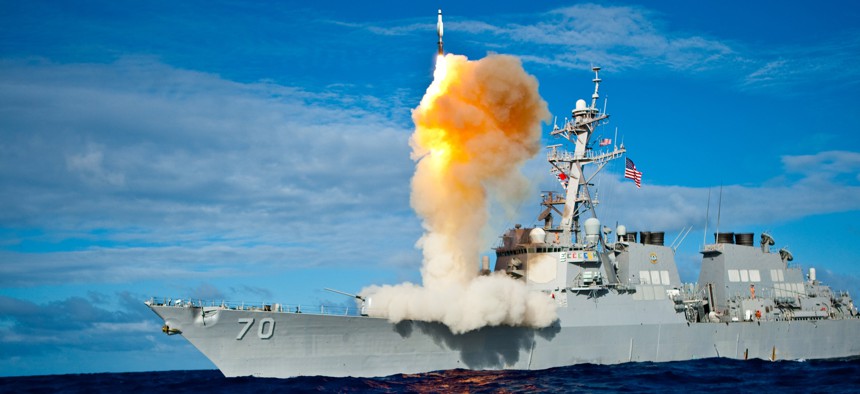
A Standard missile launches from the U.S. Navy destroyer Hopper. MDA photo
The New Missile-Defense Policy Won’t Make Us Safer
Instead, it will encourage rogue states to nuke first in a conflict, and will increase the risk of escalation in a great-power war.
The Trump administration’s long-awaited Missile Defense Review sets the stage for a broad expansion of U.S. missile defense capabilities that would make the country less safe. Perhaps this seems paradoxical; shouldn’t better defenses increase our security? Yet the proposed new systems would not exist in a vacuum, but would interact with existing and emerging technologies and nuclear strategies to produce a more dangerous world.
The MDR is a very ambitious document. It starts with calls for more midcourse interceptors and other existing defensive systems, then urges the development of new capabilities to defeat more kinds of adversary missiles across more stages of flight. Examples of these new systems include: laser-armed drones that could disrupt missiles before they leave the atmosphere, space-based sensors to improve early detection of missile launches, and F-35s equipped to hunt mobile missiles before they can be fired.
Supporters of a bigger and better U.S. missile defense capability argue that it improves deterrence by reducing adversaries’ confidence in their ability to launch successful attacks against the United States, its military forces, and allies. This argument has some merit, but it overlooks the negative effect missile defense has on nuclear stability when other factors are considered.
Let us take a closer look at the MDR’s likely effects on two types of deterrence relationships: with “rogue states” such as North Korea and Iran, whose existing or potential nuclear arsenals will remain relatively small; and with China and Russia, who possess much larger arsenals.
Related: Pentagon to Study Putting Anti-Missile Laser Weapons in Space
Related: How America Protects Its Citizens From Ballistic Missiles
Related: Trump Tried Partisan Applause Lines Inside the Pentagon. Nobody Applauded.
Far from deterring rogue states, the MDR’s prescriptions would encourage them to use nuclear weapons at the start of a military conflict. Although North Korea has demonstrated that it can likely hit U.S. territory with a nuclear-armed ICBM, its forces are still very small and vulnerable to both U.S. offensive capabilities and missile defenses. If war broke out between the United States and North Korea, the U.S. military would most likely try to destroy the North’s nuclear forces and its leadership very quickly. The longer Kim Jong Un waits to use his nuclear weapons, the more likely it is that he won’t have any weapons left. This is not just speculation: when U.S.-North Korea tensions ran high in 2017, the North repeatedly said it would use nuclear weapons if it felt that it was about to come under attack. Stoking first strike incentives doesn’t buttress deterrence, it undermines it and puts the United States at greater risk.
Nor will the MDR help deter potential adversaries with large nuclear arsenals. While the MDR says that rogue states like Iran and North Korea are the primary target of U.S. defenses, Russia and China have never believed U.S. assurances; they regard American missile defenses as particularly threatening to their own nuclear forces. Adding to this distrust is the Pentagon’s interest in new low-yield nuclear weapons, as described in the 2018 Nuclear Posture Review, and the new focus on great power competition laid out in the latest National Security Strategy.
The combination of a more advanced and comprehensive U.S. missile defense architecture with increasingly potent offensive strike capabilities—both conventional and nuclear—will likely accelerate Russian and Chinese efforts to develop and deploy new nuclear weapons, which in turn will encourage future U.S. defenses, and so on. This offense-defense arms race is unlikely to lead to massive, Cold War-style nuclear buildups, but ratcheting up already elevated military tensions will not make the United States safer.
Finally, the MDR’s recommendations would also increase the risk of inadvertent nuclear escalation during a conventional conflict between nuclear powers. Inadvertent escalation occurs when one country attacks against an adversary for conventional purposes but destroys a system the target country sees as necessary for using its nuclear forces. The target country, fearing that its nuclear deterrent is under attack, then uses its remaining nuclear forces before it suffers more damage.
The MDR increases these risks. For example, pursuing a space-based sensor layer for missile defense encourages adversaries to target U.S. satellites to make sure their missiles can get through. However, many U.S. space-based sensors are used for other missions besides missile defense, including early warning of enemy nuclear attack. In a conflict, it could be very difficult for U.S. leaders to tell whether the satellites came under attack because of their missile defense role or their early warning role. Moreover, if the United States has a robust missile defense system, an adversary becomes more sensitive to the loss of part of its nuclear arsenal because more forces are necessary to get through the defense. This lowers the threshold of a nuclear response to a conventional attack on nuclear forces or command-and-control systems.
Trump’s MDR does not make America safer. Missile defenses focused on protecting forward-deployed forces from attack by short-range threats would be strategically wise and technically feasible, but the MDR’s expansion of all aspects of U.S. missile defense is wasteful and destabilizing.



